
By Colonel John Gargus USAF (Ret)
When I was a ten-year-old boy in 1944, I visited the crash site of a Russian Li-2s transport aircraft which impacted into a wooded hill just about one kilometer from my native home in Vel’ká Poloma, Slovakia. It was a terrible experience which I have been recalling throughout my lifetime. Aircraft fuselage, which was a copy of an American C-47, was broken up into several pieces that were strewn among crash damaged trees. Eighteen fighters who came to participate in the Slovak National Uprising died there. They were Slovak and Russian volunteer partizans and all the members of the aircraft’s crew.
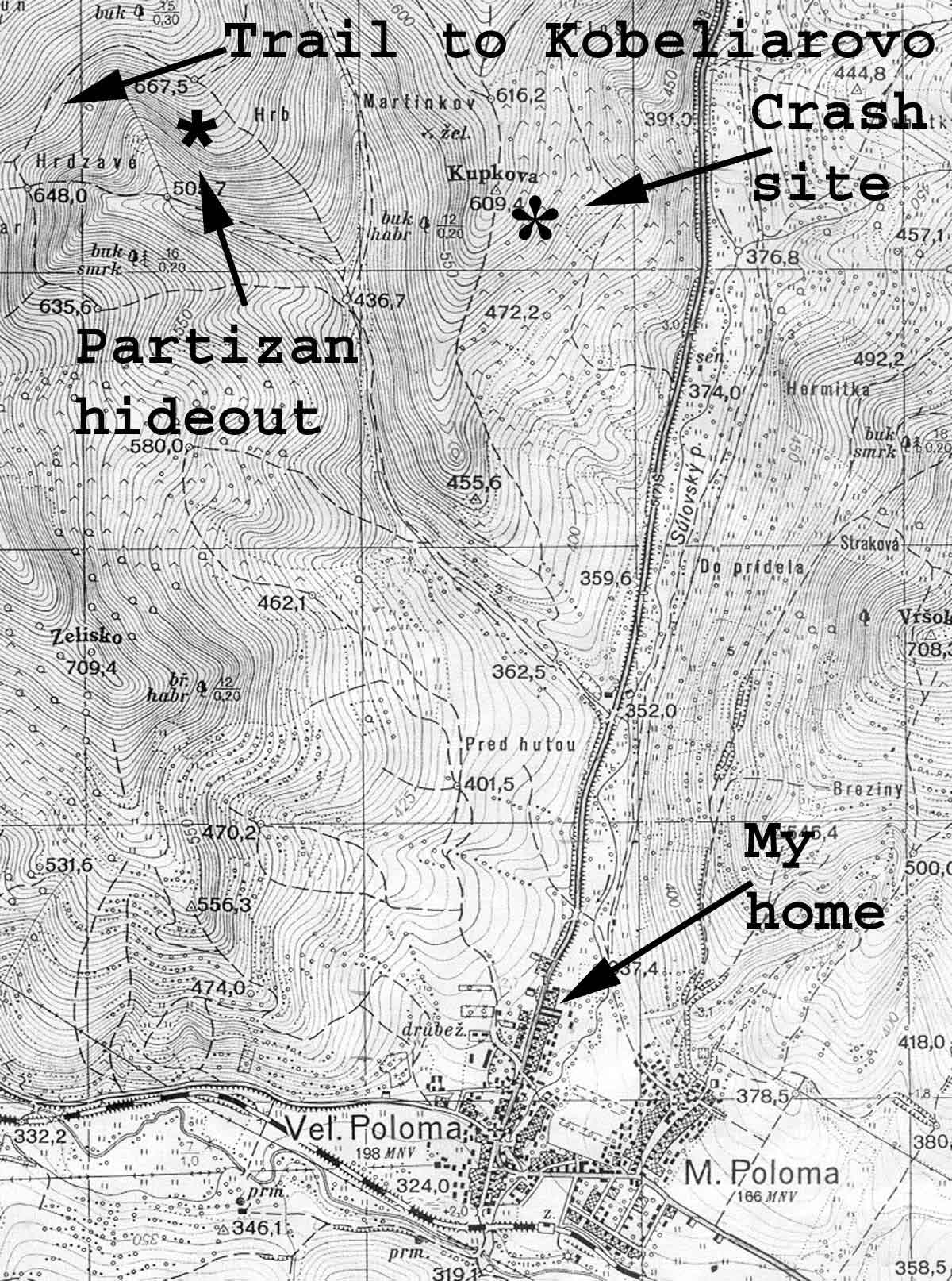
This map shows Vel’ká Poloma with my native home and the location of Russian aircraft‘s crash. It also shows the location of the partizan hideout and the trail from a safe house in Kobeliarovo. (Courtesy John Gargus)
My second encounter with a crashed aircraft came just four months later on a snowy field south of newly liberated county town Rožňava. This time it was an American B-17 Flying Fortress which made a successful belly landing in deep snow. The bomber sustained extensive battle damage during its mission somewhere over Poland and could not return to its home base in Italy. Its fuselage was intact and, apparently, the crew survived and found refuge in the nearby forest.
I visited this aircraft with two of my classmates from Rožňava’s secondary school that had reopened after war’s frontal passage in January 1945. We were awed by the size of this huge four engine bomber. It was structurally intact; however, its insides were stripped of all instrumentation and other removable parts. There was plenty of visible battle damage from anti-aircraft artillery and perhaps even from some interceptors that might have attacked it from the air. I sat down in each crewmember’s seat and imagined how it must have been to sustain all that crippling damage. Still movable gun turrets fascinated me the most. Even though I had not yet flown in an airplane before I imagined how it must have been to defend this bomber against the swifter enemy interceptors that must have swarmed around such huge and slower moving airplane.
Seventy-six years later, in 2021, my brother forwarded me an article about a lady from Rakovnica, Helena Mišurdová, who was a nurse that helped two of the injured crewmembers of this aircraft. She hid them in the basement of her hospital until the Russians liberated Rožňava. This article was published in the 24 September 2021 issue of Ľítanie na Vikend. The story had a photograph of two turret gunners and revealed that their bomber was one of 31 that departed from Italian air base at Torretta to bomb targets in Poland. The bomber formation came under enemy attack while flying over Hungary and this Flying Fortress became one of its victims.
Much earlier, in 1953, when I was already a second-year university student in the USA, I visited my godfather Ľudovit Linczenyi in Canada during Christmas holidays. He was the older son of Paloma’s Lutheran minister who had been a democratic representative in the Czechoslovak legislature. He had to escape to Germany after the Russian supported Communist Party took over the government in February 1948 and he became a political target as an enemy of the state. Eventually, he immigrated to Canada. He informed me about how he and my father escorted two escaping American airmen of Rožňava’s Flying Fortress from Kobeliarovo to a band of partizans in a Súlová forest near my home so that they could lead them across the front line into Russian custody.
This revelation surprised me because our father never shared the event with our family. Godfather asked me to help him to locate the two airmen. Because part of my university education was Air Force Reserve Officer Training Corps (AFROTC) he thought that I could find out how to find such airmen. I was sure that I could help because I knew that Colonel Luther Bevins, commander of our ROTC department, was a former B-17 pilot. I also knew that he had flown in the B-17 bombers from a base in Italy. He did not recall the loss of this aircraft because there were too many of them.
The Colonel was confident that he could find out about the fate of the airmen. Godfather did not have their names, but he gave me their photograph that was of poor quality because it was taken by the light of a kerosene lantern. Their faces were too white and lacked distinguishing features. He learned after the war that their escape to the Russian occupied territory was not successful. They were captured by the Hungarians at the next safe house and turned over to the Germans. Because the Germans were known for treating American prisoners of war properly, Col. Bevins believed that they probably survived their German imprisonment. He wrote articles for some military publications with details of the crash and their unsuccessful evasion. He received a reply from only one magazine. It was the one that received the only existing photo of the airmen. The reply was that they were not able to publish the photograph because of its poor quality. Other magazines did not respond to the searching stories.
In 1990, after the fall of the Iron Curtain, it was safe for me to return to my native village, where I spent much time in the attic of the house in which I was born. There I scanned through family documents and photographs covering my 41 year period of separation from the family. One of the most significant documents I located was a short testimony letter drafted by my godfather in his capacity as a democratic representative of national legislature. It described how he and my father escorted two American airmen from a safe house in Kobeliarovo to custody of partizans on the way to the next safe house in Henclova, a small isolated village that was at that time very close to the Russian front line.
Here is a loose translation of my godfather’s document:
I hereby attest that Ján Garguš, born on March 10, 1908, in Ve ľká Poloma, teacher, currently serving at a middle school in Rožňava, continued in underground service after the cessation of the Slovak National Uprising against the occupying German forces. I joined with him in saving and hiding American airmen who were forced down near Rožňava. Two airmen were successful in evading and hiding in Kobeliarovo. We assisted them by delivering them to a partizan unit that would take them to a safe house in Henclová and then across the front line into Russian custody. Their safe passage did not succeed. They were captured by the Germans in Henclová.
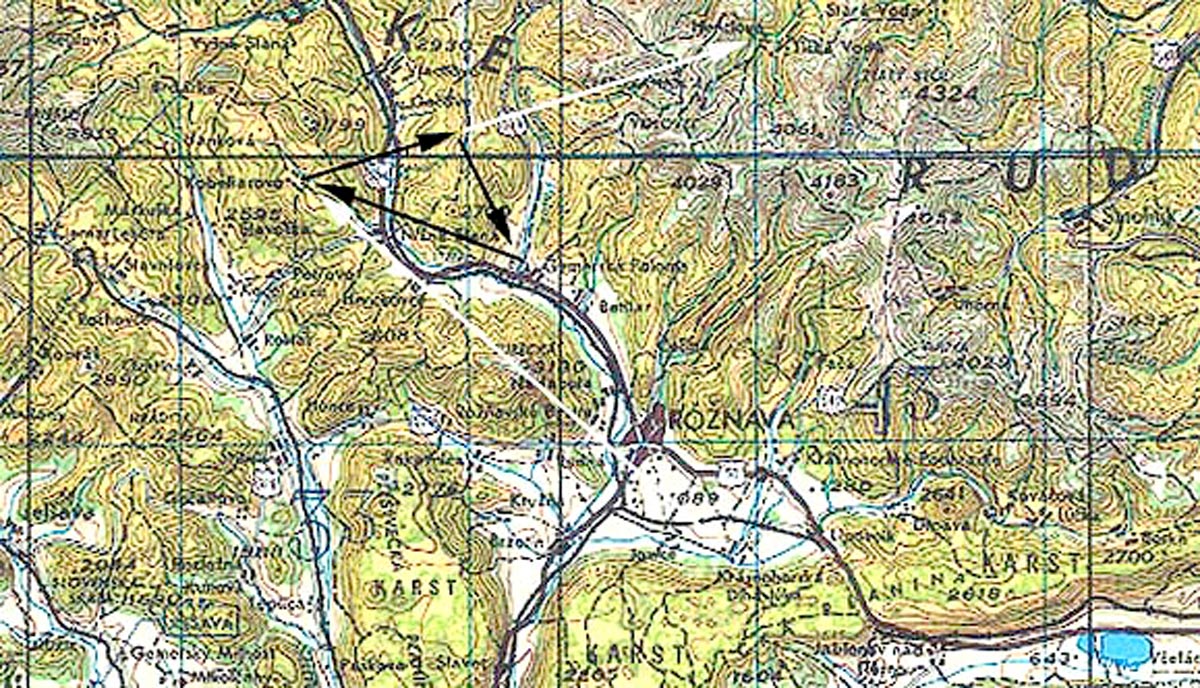
This map shows the location of the B-17 crash landing south of Rožňava. White line shows the escape route for American airmen through Kobeliarovo to Henclová. Black line shows the route traveled by Garguš and Linczényi to the partizan hideout. (Courtesy John Gargus)
My father’s role in this clandestine escort of American airmen was well within his role as a prior soldier in the Slovak National Uprising which ended in October 1944. It was his military duty to facilitate local assistance to allied airmen whose planes were forced down in his rebellious region of the country. As an intelligence officer for his Astra brigade, he probably knew all the safe places and routes within the Slaná valley which they defended from the Germans. Very likely he knew some of the people of the underground railroad that was established for this purpose. Someone knew to come to him with information about the two airmen hiding in Kobeliarovo and he acted on it with his buddy Linczényi.
My own first exposure to escape and evasion occurred during the Vietnam War. There I served as a crew member and mission planner in special operations aircraft known as Combat Talons. We flew clandestine nighttime missions over North Vietnam for a very secret organization known only as Studies and Observation Group (SOG). We infiltrated agents into North Vietnam, resupplied them as needed and dropped propaganda leaflets from high altitudes. These missions were like those flown by the Russian crew which crashed north of my native village. In Vietnam the geography and the closeness of friendly territory was such that there was no need for safe houses to assist downed crews. Also, the helicopter search and rescue had already evolved to such a degree that surviving airmen could be picked up soon after their aircraft were shot down. The most important concern for our Combat Talon crews was to identify suitable crash-landing locations along their mission routes.
Escape and evasion scenario was much different when I came to the 7th Special Operations Squadron in Germany where I once again served as a mission planner. Our wartime missions called for infiltration of special forces teams or agents into Warsaw Pact countries where we would resupply them, as needed. We could even extract some of them and bring them home with our capability with Fulton’s surface to air recovery system (STARS). We also had suitable crash-landing areas and a network of supporting safe houses behind the Iron Curtain through which able survivors could be escorted to friendly NATO forces.
We conducted Cold War training exercises called Flintlocks with the Army Special Forces (Green Berets) and with army and navy Special Forces counterparts of allied nations. As we would do after the start of hostilities, we deployed our whole squadron to England for six weeks where we received special operations aircraft reinforcements from U.S. Air National Guard units. From there we planned and flew missions to friendly countries, which at that time included even distant Iran. We parachuted infiltrators and resupplied them as needed. We could not do high altitude leaflet drops because these would cause undue political and litter problems, and live STARS rescues, which would have required very extensive coordination and approval from countries where they could interfere with their normal air traffic controls. Our Special Forces partners from Bad Tölz, who were responsible for psychological operations, designed sample propaganda leaflets for targeted populations in all East European languages. These could never be dropped or released to anyone. Their fictional anti-communist propaganda content was very sensitive and carried high security classification
Things we could not exercise during Flintlocks, we accomplished in required annual paper mission planning. My small staff would design a mission scenario with a target area for each combat ready crew, which was then tasked to prepare its low-level terrain following flight plan with all other flight documentation. We used highly classified maps of different scales that depicted various terrain details with man-made facilities. They showed all enemy air bases and lacked only the often-mobile locations of their country’s air defense radars and anti-aircraft missile and artillery positions. We simulated these by locating them in the likeliest geographical areas. Included in this mission planning were known secret safe areas where downed crews could find a degree of safety and make contacts with friendly individuals who would assist them in their return to friendly territory.
Should it become necessary to execute an actual wartime mission, each crew member would be issued a silk cloth map of safe areas along the flight route with instructions on how to proceed if forced down behind enemy lines. Hiding and patience was required once stranded in a safe area. One would have to observe and wait for appearance of a woodchopper, beekeeper, or a forest Meister who would attract friendly attention to himself.
Escape and evasion training was included in all Flintlock exercises. It was conducted by the Green Berets from Bad Tölz, who were very good at it. Participating individuals (evaders) were briefed on their roles as prisoners of war who desperately needed to get to safety. Most of their handlers or facilitators were the same men who planned their scenarios. However, they had to include some native Germans who provided hiding places in their homes and villages. First, during their days as captive prisoners of war (POW), they were subjected to intensive harsh treatment interrogations. A staged POW rescue would free them, after which they were split into singles or pairs and sent out in different directions to reach safety. To convince the evaders about the hazards for being discovered and recognized, their German facilitators would show them photographs of wanted posters with their well-sketched facial images and offers for rewards. Photographs would show these posters in make believe East German public places and police stations. Their often-traumatic experiences with hiding, foraging for food, running, and traveling at night, were credible and would last more than two weeks before they succeeded in being guided or escorted to friendly forces. I had nothing to do with planning of this part of the exercise but met with some of their planners.
Three such planners became my friends when I joined the Special Forces Association as a retiree in Las Vegas. Edward P. Davis and my native countryman Victor Kreisman, (who served in the armies of 5 nations: first in Czechoslovakia, then Belgium, England, Israel and finally the USA), had planned some of the Flintlock escape and evasion training exercises, and so did the legendary Sully H. DeFontaine, who during the Second World War, as a French resistance fighter, escorted evading American airmen through France to safety in Spain. His clandestine activity in the French underground railroad and rescue of allied airmen are documented in his autobiography titled The Slaver’s Wheel. This intriguing book focuses on his orchestrated rescue of more than 200 life threatened Christian missionaries from the former Belgian Congo. Sully sponsored me for my associate membership in Las Vegas’ SFA Chapter 51. This chapter was eventually named after him just before he died in 2019.
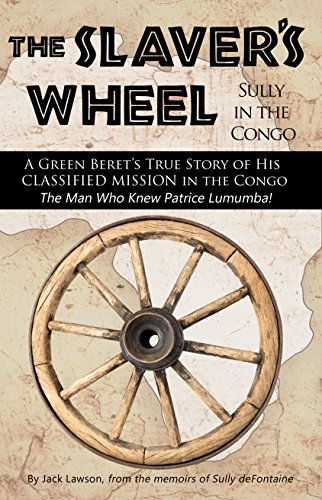
When I relocated to Manchester, NH in 2021, I joined the New Hampshire Trojan Horse SFA Chapter 72. There I met another native of Czechoslovakia, Julius Reinitzer, whose amazing experiences with escaping and evading are documented in The Nine Lives of Julius – A True Story of Survival, written by his daughter Ilona. As a senior teenager, Julius was gathered up by the Germans with other Prague students to work in a forced labor camp near Auschwitz in Poland. There the Germans performed maintenance on tanks and other motorized wartime vehicles. He escaped from there, but was captured during an unsuccessful evasion. They returned him to Poland to a forced labor camp that constructed defenses against the advancing Russians. He escaped once more, and this time succeeded in returning to Prague where he participated in the city’s uprising against the German occupiers.
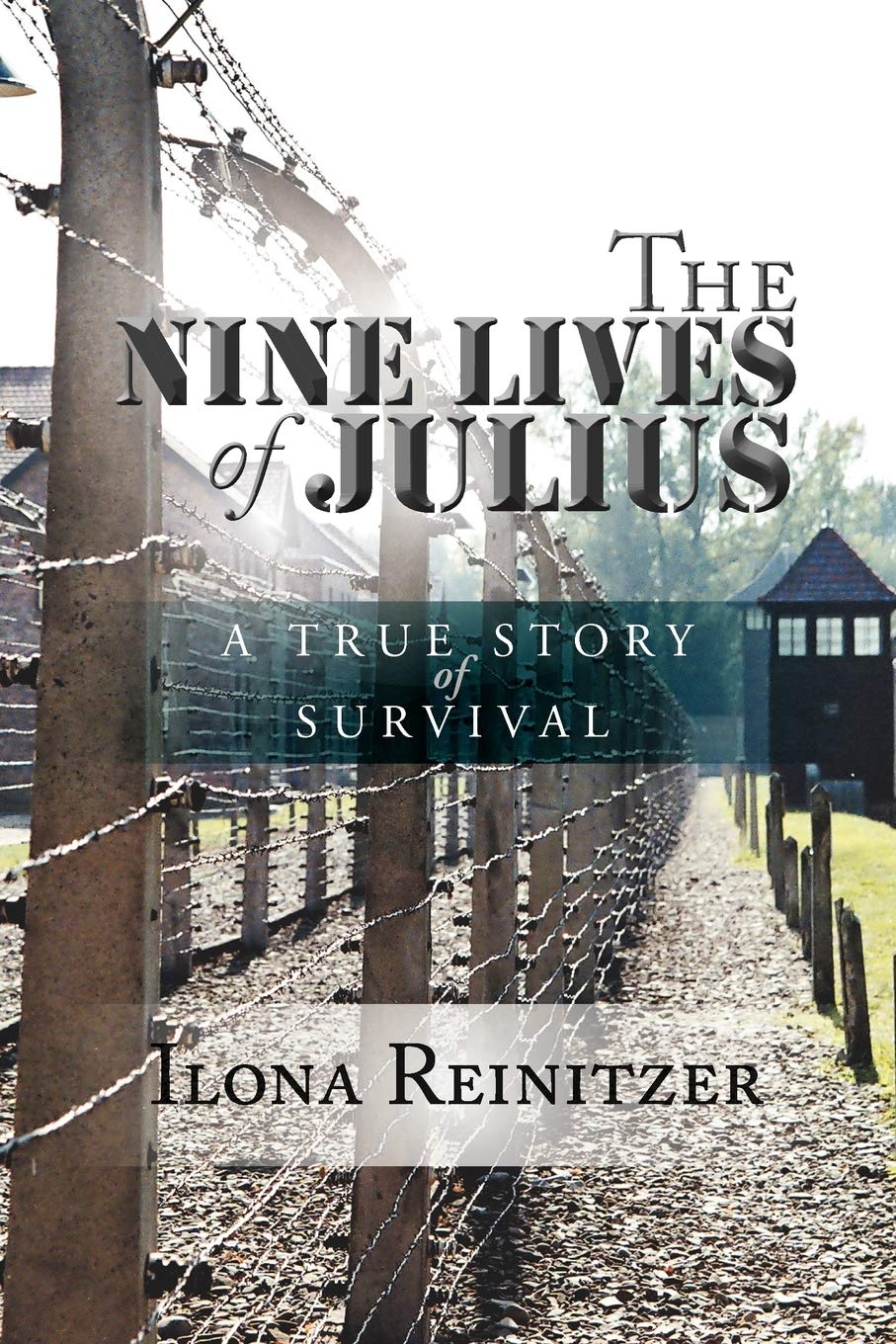
His acquired talents in resisting and escaping from German captivity became valuable after 1948 when Czechoslovakia fell behind the Iron Curtain. When his twin brother faced an arrest for his political anticommunist activities, Julius provided him a safe hiding place and then helped him to escape to West Germany. Then, when the authorities learned about his role in his brother’s escape to freedom, he also had to disappear and make his own escape to safety in Germany. Once there, he began an aggressive though unsuccessful search for his twin brother, who had by that time emigrated to Australia. This brought him to the attention of American intelligence personnel who had helped him in the search for his brother. They were impressed by his past escapes and recruited him to become an agent whom they parachuted back to Czechoslovakia to escort high valued individuals across the border to Germany. Julius became a fearless agent who risked his life repeatedly by assisting endangered individuals who had to escape from their communist persecutors. He became so successful at it that they expanded his role to establishing new underground safe houses for evading individuals.
However, after many successes his evading luck came to an end. He was apprehended on one of his missions for traveling with forged documents. That was a serious charge to which he had to confess, but his clandestine role as an American agent never came to light despite many long and harsh interrogations. He was sentenced to 14 years of hard labor in the Jáchymov uranium mine. That was more than a death sentence because there was no escape from that well-guarded camp and no one could survive that long with so much hazardous radiation. Julius knew that he had to get out of there. He recruited about ten equally desperate collaborators who managed to dig a tunnel from an abandoned mine shaft to a place outside of the prison’s security fence. Unfortunately, someone had betrayed them. They were captured while they were exiting from the painstakingly constructed escape tunnel. After harsh interrogation, all were dispersed to other forced labor camps to await new trials. This dispersal was a good outcome for Julius because it ended his virtual death sentence confinement at Jáchymov. They sent him to a not far away coal mine from which he quickly escaped. This time he evaded his would-be captors and used one of his previously used underground railroad tracks to West Germany.
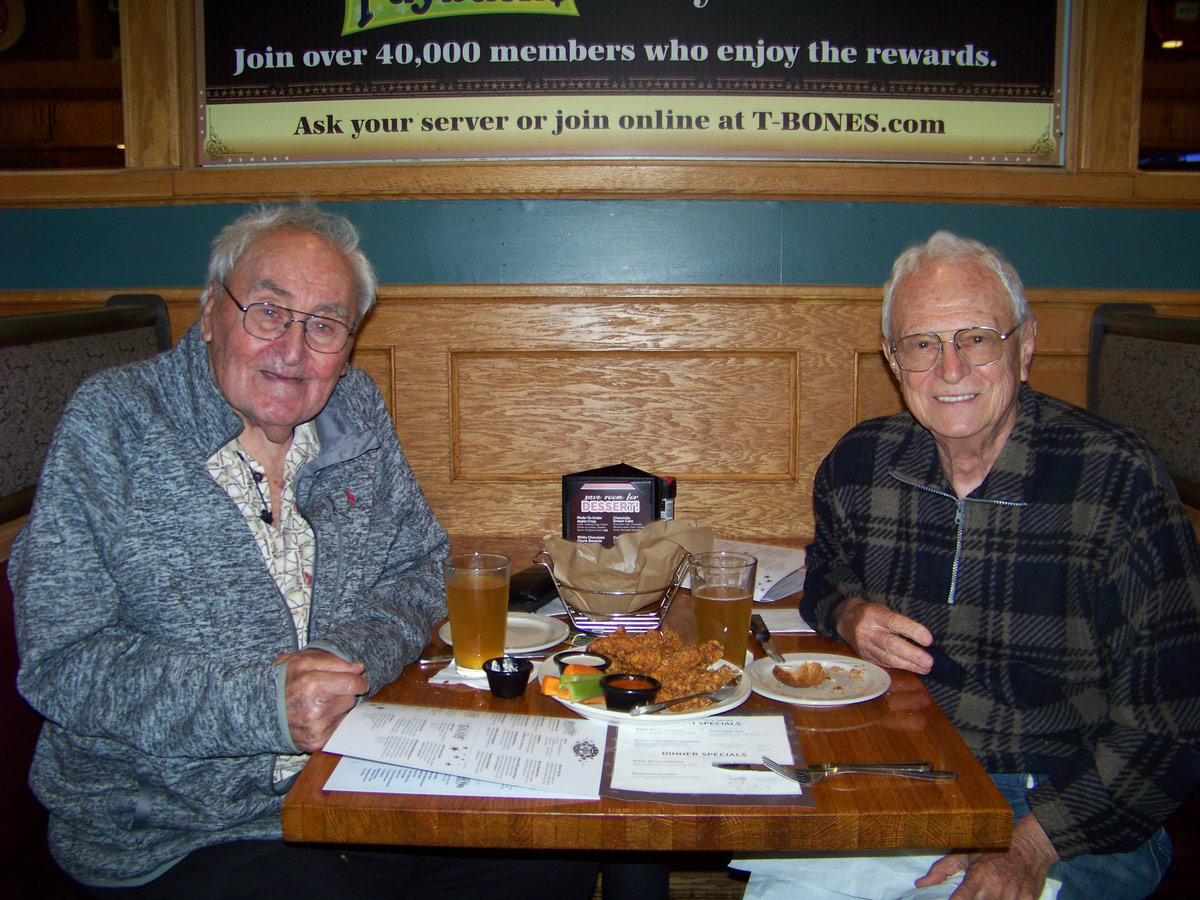
Julius Reinitzer and John Gargus in Hudson, NH in June 2022. (Courtesy John Gargus)
His American handlers were amazed upon his return. They rewarded him by helping him to join the U.S. Army where he found a good respected and very productive place for himself. When the new Green Berets were established, he eagerly joined the first wave of recruits who qualified for this highly selective special operations forces unit. He became a tremendous asset to his new country’s military which profited in many ways from his amazing skills and accomplishments in escaping and evading as well as in establishing safe houses and underground railroad nets. He spent most of his active-duty time at Bad Tölz in Germany with USA assignments at Ft. Bragg, NC and Ft. Devens, MA. He retired as a Sergeant Major in 1982.
ABOUT THE AUTHOR — John Gargus was born in Czechoslovakia from where he escaped at the age of fifteen when the Communists pulled the country behind the Iron Curtain. He was commissioned through AFROTC in 1956 and made the USAF his career. He served in the Military Airlift Command as a navigator, then as an instructor in AFROTC.
He went to Vietnam as a member of Special Operations and served in that field of operations for seven years in various units at home and in Europe. He participated in the air operations planning for the Son Tay POW rescue and then flew as the lead navigator of one of the MC-130s that led the raiders to Son Tay, for which he was awarded the Silver Star.
His non-flying assignments included Deputy Base Command at Zaragoza Air Base in Spain and at Hurlburt Field in Florida and a tour as Assistant Commandant of the Defense Language Institute in Monterey, California.
He retired in 1983 after serving as the Chief of USAF’s Mission to Colombia, having accrued more than 6,100 flight hours, including 381 combat hours in Southeast Asia. In 2003 he was inducted into the Air Commando Hall of Fame. He has authored two books, The Son Tay Raid: American POWs in Vietnam Were Not Forgotten, published in 2007, and Combat Talons in Vietnam: Recovering a Covert Special Ops Crew, published in 2017. He has been married to Anita since 1958. The Garguses have one son and three daughters.
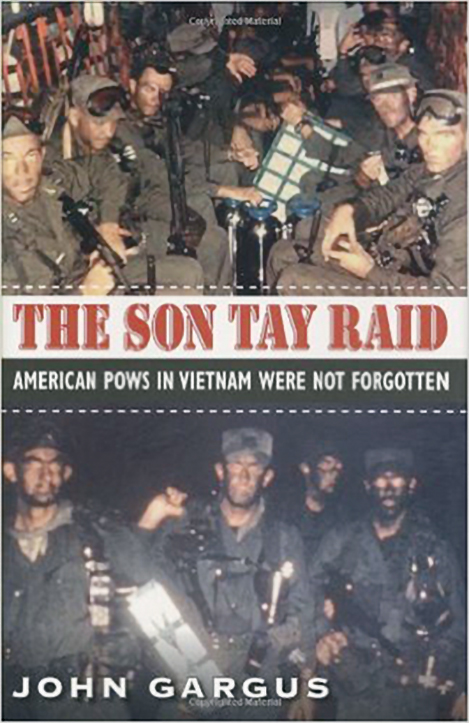
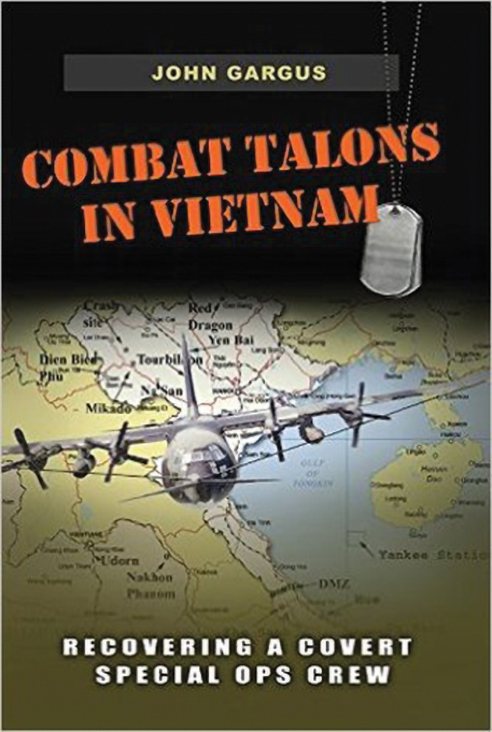
Leave A Comment